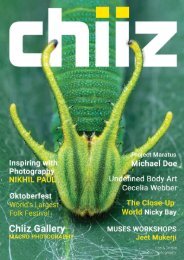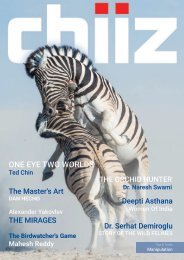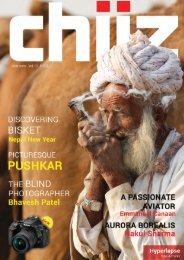Chiiz Volume 2 : Maternity Photography
Chiiz is a unique photography magazine that is dedicated to descriptive photography. In our second volume, we have tried to showcase the diversity of photography genres ranging from Birth Photography to Wildlife Photography and from Underwater Photography to Fashion Photography. It is an astounding fiesta to eyes and there is not a single photograph that can elude your attention. We are sure that the works of Brandon Mikesell, Garrett Patz and Tina Sokolovskaya is all you have to take home for a nice indulgence over a sojourn.
Chiiz is a unique photography magazine that is dedicated to descriptive photography. In our second volume, we have tried to showcase the diversity of photography genres ranging from Birth Photography to Wildlife Photography and from Underwater Photography to Fashion Photography. It is an astounding fiesta to eyes and there is not a single photograph that can elude your attention. We are sure that the works of Brandon Mikesell, Garrett Patz and Tina Sokolovskaya is all you have to take home for a nice indulgence over a sojourn.
You also want an ePaper? Increase the reach of your titles
YUMPU automatically turns print PDFs into web optimized ePapers that Google loves.
Tips and Tricks:<br />
Tilt Shift <strong>Photography</strong><br />
Tilt–shift photography is a really interesting form of photography that is catching up some interests now. It involves the use of camera<br />
movements on small and medium-format cameras, and sometimes specifically refers to the use of tilt for selective focus, often for<br />
simulating a miniature scene.<br />
Tilt is used to control the orientation of the plane of focus (PoF), and hence the part of an image that appears sharp. Shift is used to adjust<br />
the position of the subject in the image area without moving the camera back; this is often helpful in avoiding the convergence of parallel<br />
lines when photographing tall buildings.<br />
In photography, a perspective control lens allows the photographer to control the appearance of perspective<br />
in the image; the lens can be moved parallel to the film, the terms PC and TS are also used by some<br />
manufacturers to refer to this type of lens.<br />
Short-focus perspective-control (PC) lenses (i.e., 17 mm through 35<br />
mm) are used mostly in architectural photography. Longer focal lengths<br />
may also be used in other applications such as landscape, product, and<br />
closeup photography.<br />
The first PC lens manufactured for an SLR camera in any format was<br />
Nikon’s 1961 f/3.5 35 mm PC-Nikkor. Other manufacturers, including<br />
Olympus, Pentax, Schneider Kreuznach (produced as well for Leica),<br />
and Minolta, made their own versions of PC lenses. Olympus produced<br />
-The 1961 35 mm f/3.5 PC-Nikkor lens—the first perspective<br />
control lens for a 35 mm camera.<br />
35 mm and 24 mm shift lenses. Canon currently offers 17 mm, 24 mm, 45 mm, and 90 mm tilt/shift<br />
lenses, whereas Nikon currently offers 19 mm, 24 mm, 45 mm, and 85 mm PC lenses with tilt and<br />
shift capability.<br />
Shape control<br />
With a PC lens, the camera’s back can be kept parallel to the subject while the lens is moved to achieve the desired positioning of the<br />
subject in the image area.<br />
Aperture control<br />
Most SLR cameras provide automatic aperture control, which allows viewing and metering at the lens’s maximum aperture, stops the lens<br />
down to the working aperture during exposure, and returns the lens to maximum aperture after exposure.<br />
Tilt<br />
Using tilt changes the shape of the depth of field (DoF). When the lens and image planes<br />
are parallel, the DoF extends between parallel planes on either side of the PoF. With tilt or<br />
swing, the DoF is wedge shaped. The DoF is zero at the apex, remains shallow at the edge<br />
of the lens’s field of view, and increases with distance from the camera. The angular DoF<br />
increases with lens f-number, the angular DoF decreases with increasing tilt.<br />
Canon TS-E 24mm f/3.5L II<br />
Shift<br />
Shift is a displacement of the lens parallel to the image plane that allows adjusting the<br />
position of the subject in the image area without changing the camera angle; in effect the<br />
camera can be aimed with the shift movement.<br />
Nikon 24 mm lens which tilts (as seen above) and also shifts<br />
Miniature Faking<br />
Selective focus via tilt is often used to simulate a miniature scene, so much that “tilt-and-shift effect” has been used as a general term for<br />
some miniature faking techniques. Basic digital post-processing techniques can give results similar to those achieved with tilt, and afford<br />
greater flexibility and control, such as choosing the region that is sharp and the amount of blur for the unsharp regions. Moreover, these<br />
choices can be made after the photograph is taken. One advanced technique, Smallgantics, is used for motion-pictures; it was first seen<br />
in the 2006 Thom Yorke music video “Harrowdown Hill”, directed by Chel White. Artist Olivo Barbieri is well known for his miniaturefaking<br />
skills in the 1990s. Artist Ben Thomas’s series Cityshrinker extended this concept to miniature faking major cities around the<br />
world, one such example is in his first book, Tiny Tokyo: The Big City Made Mini (Chronicle Books, 2014), which depicts Tokyo in<br />
miniature.<br />
Applications<br />
With a perspective control lens, however, the lens may be shifted upwards in<br />
relation to the image area, placing more of the subject within the frame.<br />
Another use of shifting is in taking pictures of a mirror. By moving the camera off<br />
to one side of the mirror and shifting the lens in the opposite direction, an image of<br />
the mirror can be captured without the reflection of the camera or photographer.<br />
72 Vol 2<br />
Rishabh Jain<br />
rishabh@chiiz .com<br />
Youngest member and tech guy of the<br />
team. He loves finding bugs not in<br />
the backyard but in the servers. An<br />
ardent soccer fan, Rishabh is also the<br />
sports freak of chiiz.












